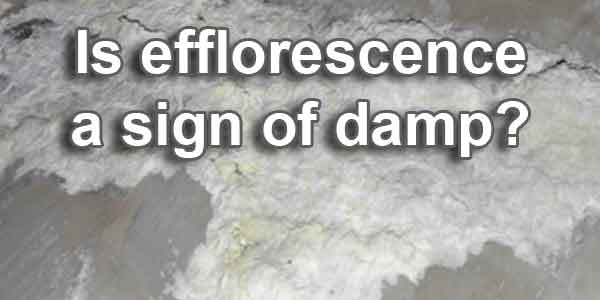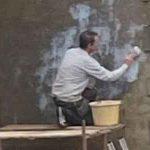The DIY Fix is reader supported. When you buy after clicking a link on our site, we may earn an affiliate commission.
Efflorescence can appear on both external and internal walls of a property. It is a white substance that consists of salt deposits which form on the walls surface.
This salt is present in building materials such as masonry and mortar. It is also present as natural salts, in the ground below a property.
Efflorescence is a sign of damp in the walls of your property. Water moves through the building materials via capillary action. As this happens, it collects salts. Once this liquid reaches the surface it evaporates and only the salt remains. This is what causes the white deposits.
This is unsightly, it is also a clear sign that excess moisture is present in the brickwork. At this point, your main goal should be to identify the problem that is causing damp and fix it.

On external walls the salts can be cleaned, but if the underlying issue remains, the efflorescence will return.
On internal walls the damage to internal plaster and decorations can be more severe. This means, you will definitely need to solve the problem before you replace any internal surfaces or redecorate. If the issue remains after you redecorate, all of your hard work will probably go to waste.
If there is still moisture passing through to the surface, it will simply result in the same problem repeating itself.
Does efflorescence damage brickwork
On its own, efflorescence doesn’t damage brickwork, but it is unsightly and can indicate a deeper problem. It can also cause damage to things like external masonry paints. The salt can cause paint to bubble and flake.
When efflorescence is clearly visible on brickwork, this means there is excess moisture in the masonry. This can cause separate problems that can be more severe.
One such problem is spalling bricks. This is another condition caused by excess moisture and is far more destructive than efflorescence. Spalling causes the bricks to crack and deteriorate. This is often noticed with the fronts of bricks falling off and the brick materials becoming softer and crumbling.
Spalling happens due to excessive water being present in the brickwork. This expands during freeze thaw cycles. Because the masonry lacks flexibility, it results in damage to the bricks.
During the manufacturing process, standard house bricks are kiln fired. This hardens them, as well as making them denser and less porous. As a general rule, the face of the brick is less porous than the inside of the brick. Therefore when spalling damages brickwork, it can actually make damp even worse, as it will allow more water to penetrate the surface.
Another problem this causes, is blown pointing. Just like the bricks, the mortar will expand and contract, causing it to dislodge between the brickwork. This will provide another route for additional damp to enter.
Efflorescence can be scrubbed off brickwork. This can be helped with an acid-based brick cleaner. However, you should do your best to identify the cause of damp and remove it, or the problem could return, and you could have more serious issues.
If in doubt, you can hire a local damp company to identify the underlying issue. Most of these companies offer some kind of free survey.
To see local damp companies that offer this kind of service Click Here
Treating efflorescence on interior walls
If you have efflorescence on interior walls, this can cause more aesthetic issues. It will form the same type of white deposits as it does externally. However, it can have a much more damaging effect to internal decorations.
When treating internal efflorescence, it is crucial that you identify and remove the source of extra moisture. If your property is relatively new, this could be natural moisture left in the brickwork, following construction.
In this case, you can scrub away the efflorescence with a stiff brush and then treat the surface with a specialist salt neutraliser, designed specifically for this job.
You should leave the surface exposed and apply heat and use something like a dehumidifier to try and extract any remaining moisture. Following this, you can redecorate.
However, in most cases there will be an underlying issue, such as rising damp, or some form of penetrating damp. It is even possible that internal moisture and condensation is causing problems.
If you have noticeable tide marks at skirting board level, then rising damp becomes more likely, although this could still be penetrating damp.
To learn more about identifying penetrating damp click here
To learn more about identifying rising damp click here
If you do manage to identify an underlying damp problem, there are often DIY solutions that can be carried out by yourself, many of which can be found on this site.
However, if you struggle to locate the cause of damp, it is much better to seek the help of a professional.
If you simply redecorate without repairing damp problems, the efflorescence will return, causing more work and expense to carry out repairs.
Hiring professionals to help with efflorescence and damp
If you do need help to identify the cause of efflorescence, hiring a local damp company is your best solution. Many will offer some kind of free survey, whilst others may charge a small call out fee.
Either way, they will identify the issue for you and recommend treatment to fix it. At this point, you can decide if you hire them to do the work, or if it’s possible to do it yourself.
The best way to hire someone locally, is via a damp comparison website. When you use this type of service, you are talking to professionals who have been vetted by the comparison site. They will also have a profile with customer reviews. This all helps you to find a reliable company.
The other major advantage is the savings you can make on work. Multiple damp companies will see your job, and this results in very competitive quotes. It also makes the chance of free damp surveys much more likely.
You can see a popular comparison site that specialises in damp companies by clicking here
Conclusion
Efflorescence is usually a sign of damp. When you notice the issue, you should take steps to identify the underlying cause as soon as you can. This will help you to lower the chance of more serious issues forming in the future.
In many cases, the fix for efflorescence can be quite simple and there is often a DIY solution. However, if you are struggling to resolve the problem, you should let a professional take a look.


